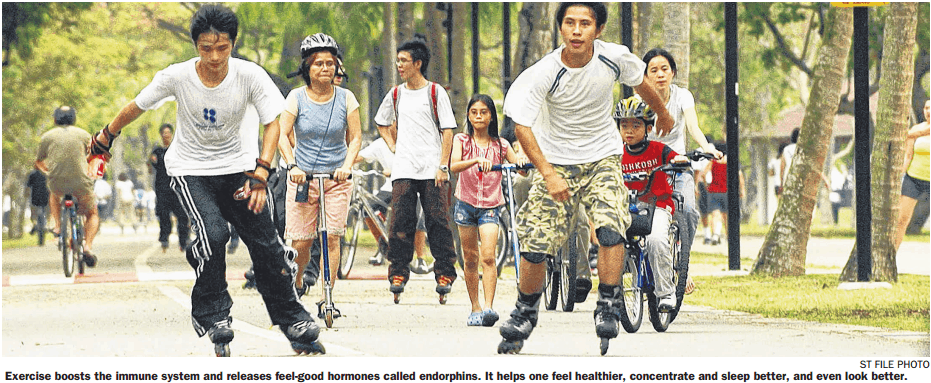Get Moving to Get Happy

Perhaps you feel like reaching out for that tub of ice cream when you are feeling down, hoping the sugar high will give your mood a lift.
Or you may prefer drowning your sorrows in a drink or two.
Yet others smoke or use drugs, legal and illegal, to try and forget their troubles.
These attempts to take one’s mind off things may or may not work. But one thing is certain – their effects are only temporary.
In fact, the person may end up feeling worse after a high from getting drunk or overeating.
If this becomes a habit or is done excessively in the long run, he may end up having to deal with issues such as obesity and alcoholism.
A much better strategy for feeling good about yourself is exercise, and lots of it.
But is there a link between exercise and happiness or mental well-being?
Studies suggest that there could well be.
Exercise or being physically active has been found to improve mental health by reducing depression, anxiety and stress as well as improve self-esteem and cognitive function, said Dr Tan Hwee Sim, consultant psychiatrist at the Raffles Counselling Centre at Raffles Hospital.
Researchers have demonstrated that active people are less depressed than inactive people, he added.
CREATING NEW BRAIN CELLS
Other studies have found exercise can be as effective as anti-depressant medication for mild depression, and in preventing relapses, Dr Tan added.
While it is unclear how moving one’s muscles can have such positive effects, some researchers suspect that exercise alleviates depression by increasing serotonin, a chemical in the central nervous system that simulates happiness, said Dr Tan.
Exercise also helps create new brain cells in the part of the brain responsible for learning and memory.
Other beneficial effects may include giving the person a sense of accomplishment and providing distraction and social interaction, which are important in combating day-to-day stress.
Exercise is linked to boosting the immune system, and also with the release of endorphins (feel-good hormones). It helps the person feel healthier, concentrate and sleep better, and even look better, said Dr Tan.
A Singapore study published last year in Biomed Central, Public Health, a British peer-reviewed online journal, also found that those who spent 10 hours a day slouching around or being sedentary were 29 per cent more likely to report having psychological distress.
Those who took part in moderate to vigorous physical activity had 27 per cent lower odds of feeling psychological distress.
PROOF OF BENEFITS OF EXERCISE
However, the study also found that the positive effects of doing an hour or two of physical activity, such as jogging or cycling, were dampened if the person spent the rest of the day slouching around, living a mainly sedentary lifestyle.
People who exercised and who also spent less than five hours a day being sedentary had the best chance of attaining optimal mental well-being, with 40 per cent lower odds of feeling distress.
In short, if you want to be happy, exercise or get out and about, even if you are not engaging in vigorous activity.
In a Canadian study published in the American Journal Of Epidemiology in 2012, people who were inactive were more than twice as likely to be unhappy as those who were active.
The study, on the long-term association between happiness and physical activity, analysed data from national population health surveys conducted between 1994 and 1995, and 2008 and 2009.
Happy respondents were classified as physically active or inactive as a baseline and were then followed up in subsequent surveys to examine their likelihood of becoming unhappy.
Leisure-time physical activity was found to be associated with lower odds of unhappiness when the researchers checked in on the participants two years and four years later.
Those who reported being inactive during both two-year cycles were more than twice as likely to be unhappy when they were followed up two years later, compared with those who were already active.
They were also more likely to become unhappy compared with those who made the switch from a sedentary lifestyle to an active one.
Going from active to inactive was also associated with increased odds of becoming unhappy two years later.
Questions remain about the type of exercise that is most beneficial for each person, said Dr Tan.
It is likely that age, gender and medical history can affect the amount of exercise needed to treat or prevent symptoms of psychological distress.
“As there is no clear answer for this yet, we may have to do some trial and error to find what works best for us,” said Dr Tan.
In general, almost-daily cardiovascular exercise is best and this can range from walking and dancing to yoga and pilates.
Just anything that gets you moving is good and even better if you do enough of it, said Dr Tan.
Preferably, the exercise should be enjoyable or it would be hard to sustain, he added.
The general recommendation is to do 30 minutes of moderate physical activity on most or all days of the week and to start slowly before expanding on the routine, he said.



